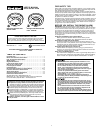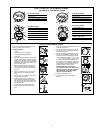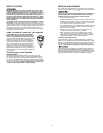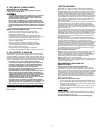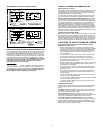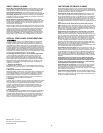
WEEKLY TESTING
NEVER use an open flame of any kind to test this unit. You might
accidentally damage or set fire to the unit or to your home. The
built-in test switch accurately tests the unit’s operation as required
by Underwriters Laboratories, Inc. (UL). If you choose to use an
aerosol smoke product to test the Smoke Alarm, be certain to use
one that has been Listed to Underwriters Laboratories, Inc. Safety
Standards, and use it only as directed. Use of non-UL Listed prod-
ucts or improper use of UL Listed products may affect the Smoke
Alarm’s sensitivity.
It is important to test this unit every week to make sure it is work-
ing properly.
Using the test button is the recommended way to test this
Smoke Alarm. Press and hold the test button on the cover of the unit
until the alarm sounds (the unit may continue to alarm for a few seconds
after you release the button). If it does not alarm, make sure the unit is
receiving power and test it again. If it still does not alarm, replace it
immediately. During testing you will hear a loud, repeating horn pattern:
3 beeps, pause, 3 beeps, pause.
3
REGULAR MAINTENANCE
This unit has been designed to be as maintenance free as possible,
but there are a few simple things you must do to keep it working prop-
erly.
Use only the replacement batteries listed below. The unit may not
operate properly with other batteries. Never use rechargeable
batteries since they may not provide a constant charge.
• Test it at least once a week.
• Clean the Smoke Alarm at least once a month; gently vacuum the
outside of the Smoke Alarm using your household vacuum’s soft
brush attachment. Test the Smoke Alarm. Never use water, clean-
ers or solvents since they may damage the unit.
• If the Smoke Alarm becomes contaminated by excessive dirt, dust
and/or grime, and cannot be cleaned to avoid unwanted alarms,
replace the unit immediately.
• Relocate the unit if it sounds frequent unwanted alarms. See
“Locations to Avoid for Smoke Alarms” for details.
• When the battery becomes weak, the Smoke Alarm unit will
“chirp” about once a minute (the low battery warning). This low
battery warning should last for 30 days, but you should replace
the battery immediately to continue your protection.
Choosing a replacement battery:
Your Smoke Alarm requires one standard 9V battery. The following
batteries are acceptable as replacements: Duracell #MN1604, (Ultra)
#MX1604; Eveready (Energizer) #522. You may also use a Lithium bat-
tery like the Ultralife U9VL-J for longer service life between battery
changes. These batteries are available at many local retail stores.
Actual battery service life depends on the Smoke Alarm and the envi-
ronment in which it is installed. All the batteries specified above are
acceptable replacement batteries for this unit. Regardless of the manu-
facturer’s suggested battery life, you MUST replace the battery imme-
diately once the unit starts “chirping” (the “low battery warning”).
USING THE REMOTE FLASHLIGHT TEST FEATURE
These Smoke Alarms have a Remote Flashlight
Feature which activates the test button when you
wave a strong flashlight beam across the sensor.
The Remote Flashlight Test method works best on flat
ceilings up to 15 feet high. Wave a flashlight with a
strong beam rapidly back and forth in a straight line
across the test button—at least 3 feet in each direc-
tion—until the alarm sounds. If this method does not
work, use the test button to make sure the alarm is
working. If it alarms, try the Remote Flashlight Test
method again, making sure to wave the flashlight very
rapidly across the test button. You may need to test
wall-mounted units, or units on peaked or gabled ceil-
ings manually.
TESTING ESCAPE LIGHT
®
FEATURE
(SA150B ONLY)
The Escape Light
®
should always shine during testing. If the horn
sounds, but the light does not shine, install a fresh alkaline battery in
the “Alkaline Only” battery slot, make sure the bulb is not burned out,
and re-test. If the light still does not shine, the unit should be replaced.
The low battery warning “chirp” only identifies that the battery powering
the alarm is getting weak. Testing the Smoke Alarm is the only way
to make sure the Escape Light
®
is working properly.



